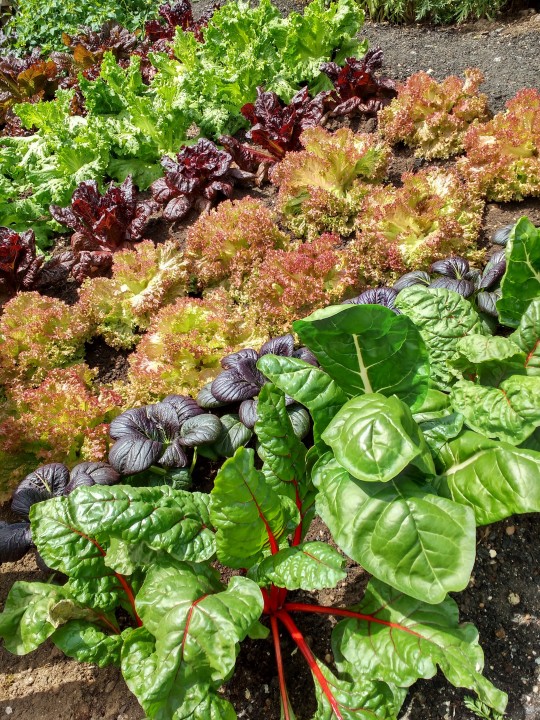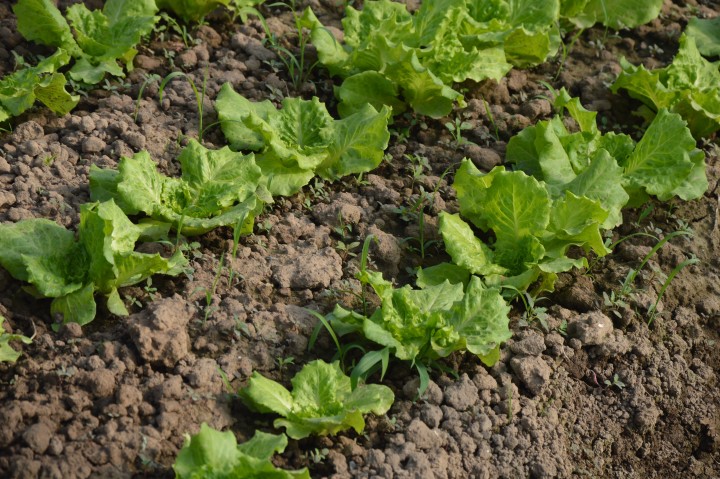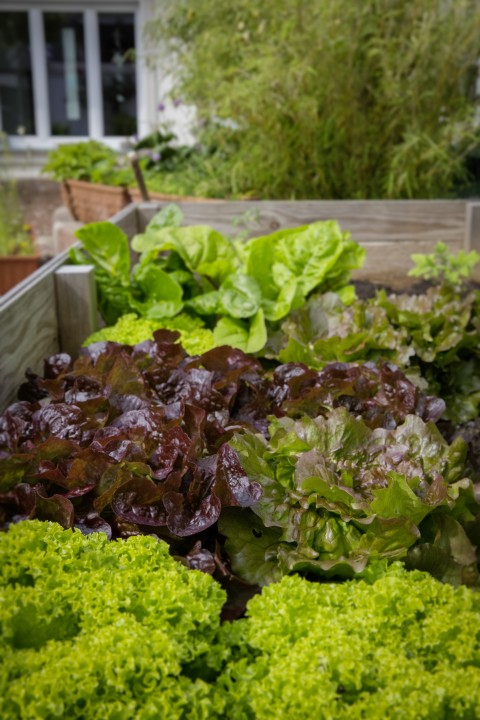How to Grow Lettuce Year Round
Supermarket lettuce just can’t compare to the taste of homegrown lettuce, so why not grow lettuce all year round? Growing lettuce in your own garden is simple and requires minimal effort, yet yields big rewards.
Nothing beats a salad made with homegrown lettuce, and with a little planning and proper seed selection you can grow lettuce in your vegetable garden year-round. Here are how you can get started!

Grow Lettuce Successfully with These 5 Basic Types
When deciding to grow lettuce year-round, there are 5 basic types of lettuce that can be grown in your vegetable garden.
- Butterhead – This type of lettuce is also called bibb, Boston or limestone lettuce. It has soft, buttery-smooth leaves, and this type of lettuce is heat tolerant, bolt resistant and has a great taste.
- Crisphead – This type of lettuce forms large, cabbage-like heads and requires a long, cool growing season making it difficult to grow in most of the United States. There are only a few varieties that can be grown successfully in a home garden.
- French Batavian – This is also called summer Batavian or loosehead lettuce. They start growing as loose-leaf lettuce and eventually form loose-heads similar to crisphead or romaine lettuce. This type of lettuce is quite heat tolerant.
- Looseleaf – This variety of lettuce produces headless plants, with the developing for the center of the plant. Most looseleaf lettuces will keep producing as long as you harvest. This type of lettuce is heat tolerant and slow to bolt.
- Romaine – This type of lettuce produces tall heads with long, upright leaves and crisp spines. Romaine lettuce, like crispheads, requires a long growing season and bolts readily in warm weather. For most gardens, Romaine lettuce is a fall crop.
While all of these types of lettuce are not necessarily suitable for year-round growing, they can provide you with some options. Depending on your climate and the varieties of lettuce you choose, you can plant for a staggered harvest.
Grow Lettuce in all Seasons
Here are some lettuce varieties that grow well during each gardening season, of course, you should research the best variety for your climate:
Spring Lettuce
Since lettuce is considered a cool-weather crop, most gardeners plant lettuce as soon as the soil can be tilled in the spring. You can even sow your seed indoors starting in mid-February if you want an earlier start.
The early varieties of lettuce tolerate light frost, therefore you can plant your seedlings well before the last frost date for your area.
Varieties for Early Spring
- Butterhead – Esmeralda, Four Seasons, Tom Thumb
- Crisphead – Mini Green, Summertime
- Looseleaf – New Red Fire, Redina, Tango
- Romaine – Freckles, Little Caesar, Little Gem
Varieties for Late Spring
- Butterhead – Burpee Bibb, Buttercrunch
- Looseleaf – Green Ice, Red Deer’s Tongue, Slobolt
Summer Lettuce
Summertime is probably the most difficult season in which to grow lettuce; however, it is possible with the right varieties. Crispheads and Romaines bolt when it gets hot, so the best lettuce to plant is looseleaf.
When growing lettuce during the summer, it is important to make sure that your plants get some shade during the hottest part of the day. You can grow lettuce under lattice, on the north side of trellised pole beans or stretch some cloth over the bed.
Water is also important. Be sure to provide a consistent supply of water, especially during periods of dry weather. A deep soaking a couple of times a week should be adequate.
Summer Varieties
- Butterhead – Burpee Bibb, Buttercrunch
- French Batavian – Nevada Green, Santa Fe, Sierra
- Looseleaf – Might Red Oak, Prizeleaf
- Romaine – Corsair, Craquerelle du Midi, Jericho
Fall Lettuce
The trick to growing lettuce in the fall is to find varieties that can tolerate the late-summer heat while dealing with the potential for light frosts.
It is best to start your fall lettuce indoors and transplant them in your garden later to help them get established.
Fall Varieties
- Butterhead – Four Seasons, Tom Thumb, Rougette du Midi
- Looseleaf – Green Ice, Lollo Rossa, Red Oak Leaf
- Romaine – Brune D’Hiver, Sucrine
Winter Lettuce
Few gardeners grow lettuce in the winter, but actually winter lettuce often tastes the best. It is important to choose varieties that are bred for short day lengths and cold temperatures.
Sow your winter lettuce in late summer or fall to allow the plants to set roots and develop hardy leaves before it gets too cold.
Lettuce will perform best in a cold-frame allowing you to harvest lettuce throughout the winter.
Winter Varieties
- Butterhead – Arctic King, North Pole, Val D’Orge
- Romaine – Brune D’Hiver, Rouge D’Hiver
- Looseleaf – Winterwunder

Sowing Lettuce Seeds
Lettuce grows best when the soil is cool and moist. Therefore, it is important to water your lettuce regularly. Lettuce generally germinates within a week of sowing the seed; however, some varieties can take up to two weeks to sprout.
Sow the seeds about ¼-inch deep in rows about 12-inches apart and thin the seedlings out to about 4-6 inches apart.
It is also a good idea to add some organic matter such as compost or manure to your garden bed before planting lettuce seeds. This will help retain moisture while providing essential nutrients for the plants.
Watering and Fertilizing Lettuce
Lettuce needs a consistent supply of water to remain healthy. It is best to provide your lettuce with about 1-2 inches of water each week, either through rain or irrigation.
Fertilizing is not necessary when growing lettuce in the home garden; however, if you want bigger and healthier plants, it is recommended to fertilize your lettuce every three weeks.
A balanced fertilizer with an NPK of 10-10-10 or a liquid fertilizer applied according to the package directions should do the trick.
Since we eat lettuce straight from the garden, it is important to make sure that any fertilizer you use is labeled as safe for edibles, and that there are no chemical residues in your lettuce.
Alternatively, you can use compost or manure tea to fertilize your lettuce. This is a safer and more organic way of providing nutrients to your plants without the risk of chemical residues.
Pest Control for Lettuce
Lettuce is not particularly susceptible to disease; however, it can be attacked by various pests including aphids, leaf miners, slugs and snails.
The best way to prevent pest infestations is to keep your garden clean and free of debris, weeds and other plants that can attract pests. You should also use row covers or protective netting when growing lettuce if you live in an area with heavy insect pressure.
If your lettuce does become infested, there are several organic sprays that you can use to kill pests. Neem oil, insecticidal soap and horticultural oils are all effective at controlling soft-bodied insects.
You can also make mixture of water, chili, garlic and soap to spray on the plants; this will help keep the pests away without harming your lettuce.
Harvesting and Storing
Harvest lettuce by cutting the entire plant at the base of the stem. The best time to harvest is in the morning when there is still some dew on the leaves.
After harvesting, be sure to rinse your lettuce with cold water. This will help remove any potential contaminants and make them taste their best.
If you don’t plan to consume your lettuce right away, wrap it in paper towels and store it in a plastic bag in the refrigerator. Be sure to use the lettuce within three days for optimal taste and quality.
With these tips, you can now grow lettuce year-round. The key is to choose the right varieties for each season and provide them with plenty of water and protection from excessive heat or cold. With a little bit of love and care, your lettuce plants will thrive in any season!

Frequently Asked Questions
These are questions that are commonly asked by home gardeners about growing lettuce year-round:
Q: How do you keep lettuce growing all year round?
A: The best way to keep lettuce growing all year round is to select varieties that are suited for the particular season. You should also provide your lettuce with a consistent supply of water, appropriate levels of sunlight, and some protection from extreme temperatures.
Q: Can I grow lettuce indoors year round?
A: Yes, you can grow lettuce indoors year round, provided you have the right conditions. You will need to choose a variety that is suitable for indoor growing and provide consistent light, water and air circulation.
Q: How do you keep lettuce growing?
A: To keep lettuce growing, you need to provide it with consistent watering, appropriate levels of sunlight and some protection from excessive heat or cold.
It is also important to fertilize your lettuce every three weeks and remove any weeds or debris that can attract pests.
Once the leaves are mature, harvest the lettuce by cutting the entire plant at the base of the stem. Be sure to rinse your lettuce with cold water before storing it in the refrigerator for up to three days. With these tips, you can enjoy fresh lettuce year-round!
Q: Can you grow lettuce year round in Florida?
A: Yes, it is possible to grow lettuce year round in Florida. The key is to choose varieties that are suited for the particular season and provide them with plenty of water and protection from extreme temperatures.
You should also make sure your garden bed is well-drained and fertilize your plants every three weeks. This way, you can enjoy a healthy harvest of lettuce throughout the year in the Sunshine State!
Q: What is the best time to plant lettuce?
A: The best time to plant lettuce is in late summer or early autumn when the soil is still warm. This will ensure your lettuce has enough time to mature before winter temperatures arrive.
You should also sow your seeds in rows about 12-inches apart and
Q: How many months does lettuce take to grow?
A: Depending on the variety, lettuce usually takes between 30-60 days to mature. If you sow the seeds in late summer or early autumn, your lettuce will be ready for harvesting by wintertime.
Keep in mind that lettuce grows best when planted at temperatures between 55°F and 75°F. If temperatures get too hot or cold, it will take longer for your lettuce to mature.
Q: What type of lettuce is easiest to grow?
A: The easiest type of lettuce to grow is leaf lettuce. This type of lettuce does not require pollination and can be harvested as soon as the leaves reach maturity.
Iceberg and butterhead lettuces are also fairly easy to grow, although they may take slightly longer to mature than leaf lettuce. It’s important to choose varieties that are suited for the particular season so you can enjoy a healthy harvest year-round!
Q: Can you grow lettuce all year round in a greenhouse?
A: Yes, you can grow lettuce all year round in a greenhouse. However, it is important to provide the plants with enough light and ventilation so they don’t become too hot or cold.
You should also make sure your greenhouse is well-drained and fertilize your lettuce every three weeks. This will ensure you get a healthy harvest of lettuce even in the wintertime!
Q: Does lettuce regrow every year?
A: No, lettuce does not regrow every year. After harvesting, you will need to sow new seeds in order to get a new crop of lettuce.
However, some varieties of lettuce may self-seed and come back the following year if conditions are favorable. It is also important to keep your garden free from weeds and debris in order to prevent pest infestations.
Q: How do I pick lettuce so it keeps growing?
A: The best way to pick lettuce so it keeps growing is to harvest the outer leaves first. This will allow the inner leaves of the plant to continue maturing and provide you with an ongoing supply of fresh lettuce.
You should also make sure that your garden bed is well-drained and fertilize your plants every three weeks. With these tips, you can enjoy a continual harvest of lettuce all year round!